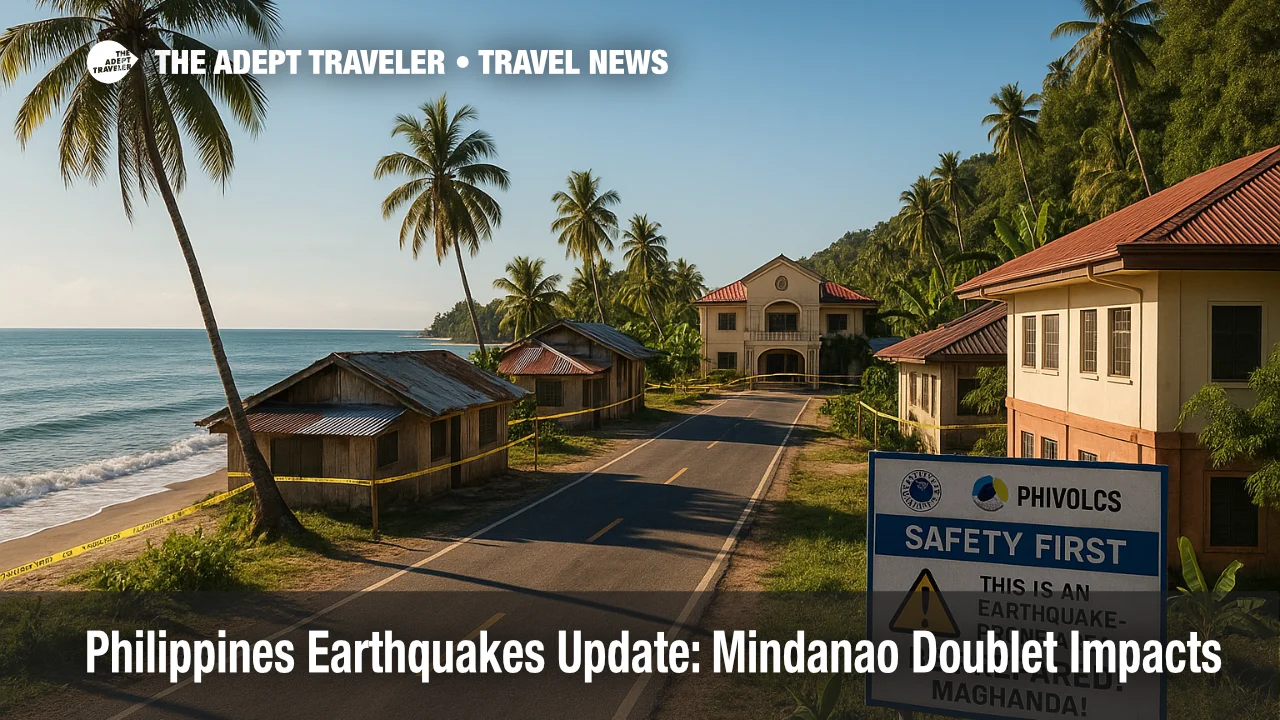Philippines earthquakes update: Mindanao doublet impacts

Two powerful offshore earthquakes struck near Manay, Davao Oriental on October 10, 2025, prompting brief tsunami warnings, coastal evacuations, and damage assessments across parts of Mindanao. Philippine authorities classified the sequence as a doublet, with a magnitude 7.4 mainshock followed hours later by a magnitude 6.8 event along the Philippine Trench. Aftershocks have continued through October 12 to 13 as inspectors survey roads, bridges, schools, and airports. National agencies report transport largely operational, but travelers should expect rolling checks and localized disruptions.
Key points
- Why it matters: Strong quakes caused fatalities, injuries, and infrastructure damage across Mindanao.
- Travel impact: Airports remain open, with inspections and minor facility repairs reported. Ferry and road delays are possible.
- What's next: Aftershocks are likely in the coming days; local governments continue safety evaluations.
- Tsunami alerts were lifted the same day once wave threats subsided.
- First-party agencies advise staying clear of damaged structures and following LGU guidance.
Snapshot
The October 10 offshore mainshock, measured at magnitude 7.4 to 7.5 at roughly 20 to 23 kilometers depth, was centered off Davao Oriental. A magnitude 6.8 earthquake struck later along the same trench, with authorities describing the pair as a doublet. Tsunami bulletins triggered precautionary evacuations, then were canceled when only minor sea-level changes were observed. The Civil Aviation Authority of the Philippines reported no major damage to airport runways or terminals, though minor cracking was recorded in non-critical facilities and engineering teams conducted follow-up inspections. Operations continued at Francisco Bangoy International Airport (DVO) in Davao, General Santos International Airport (GES), and other regional fields. In the Visayas, separate aftershocks followed the September 30 magnitude 6.9 event near Cebu, with ongoing monitoring.
Background
The Philippine archipelago sits on the seismically active Pacific Ring of Fire where the Philippine Sea Plate subducts beneath the Philippine Mobile Belt. Phivolcs notes that large trench-related earthquakes can generate strong shaking and secondary hazards like landslides and liquefaction, especially in steep or reclaimed areas. On September 30, 2025, a magnitude 6.9 earthquake offshore northern Cebu caused significant casualties and damage, and Mindanao's October 10 doublet added new stresses to public infrastructure and housing stock. Emergency teams prioritized life safety, rapid damage assessment, and restoration of power and communications. Travelers should anticipate periodic closures for bridge and building checks, plus short-notice advisories from local disaster offices.
Latest developments
Mindanao transport checks continue as aftershocks persist
Phivolcs' primer and rolling earthquake bulletins confirm the October 10 doublet sequence and continuing aftershocks into October 12 and 13. The U.S. Geological Survey places the mainshock east of Mindanao with oblique reverse faulting consistent with subduction geometry. Aviation authorities report that commercial flights are operating following structural sweeps, with minor non-operational damage noted at select facilities. Inter-island ferries and coastal roads may see congestion near landslide-prone segments, particularly where local governments conduct slope inspections. For broader U.S. flight reliability during this period, see our rolling update, Flight delays and airport impacts: October 12, 2025. If you are connecting via Manila Ninoy Aquino International Airport (MNL) or Mactan-Cebu International Airport (CEB), build extra time for check-in, security, and potential gate changes while inspections and staffing normalize.
Safety guidance for travelers and travel planners
Phivolcs advises expecting aftershocks for days to weeks after major earthquakes and staying away from damaged buildings until cleared by engineers. Coastal communities should observe local tsunami signage and evacuation routes even when alerts are lifted, since strong aftershocks can prompt new advisories. Airlines and airports may issue operational notices, including temporary gate or facility closures during follow-up inspections. Confirm contact details in your booking, enable airline notifications, and monitor city or provincial disaster risk offices. For itinerary flexibility, consider fares that allow free same-day changes or vouchers when irregular operations are declared. In Mindanao, prioritize daytime ground travel on inspected corridors and verify ferry schedules directly with operators.
Analysis
The earthquakes' immediate travel footprint is moderate rather than system-wide, owing to offshore epicenters, swift tsunami all-clear notices, and rapid airport checks. The largest aviation nodes, Manila Ninoy Aquino International Airport and Mactan-Cebu International Airport, lie outside the epicentral area, reducing national ripple effects for air schedules. The most plausible traveler friction points are localized, including hillside road closures for rockfall mitigation, ad hoc power outages that briefly affect terminal services, and school or government building closures that redirect traffic patterns. Because Cebu absorbed significant damage on September 30, sequential aftershock clusters raise pressure on inspection teams and contractors, which can lengthen repair timelines for non-critical facilities. For trip assurance, flexible tickets and hotel cancellation windows remain valuable as authorities continue methodical assessments. If traveling to or within Mindanao, keep contingency buffers around inter-island connections, verify airport transfers in advance, and track Phivolcs bulletins for any significant aftershock that could alter the inspection cadence.
Final thoughts
Earthquakes are a recurring fact of travel in the Philippines given its plate boundaries, but preparedness reduces risk. With airports open and inspections ongoing, the practical approach is vigilance, flexibility, and deference to local advisories. Build extra time into connections at Manila, Cebu, Davao, and General Santos, and keep an eye on official updates as aftershocks taper. That measured posture will help travelers navigate this Philippines earthquakes update with confidence.
Sources
- PRIMER ON THE 10 October 2025 magnitude 7.4 offshore Davao Oriental earthquake, PHIVOLCS
- Latest earthquake information listings, PHIVOLCS
- M 7.4, off the east coast of Mindanao, event page, USGS
- Powerful quake off southern Philippines, tsunami warnings issued, Reuters
- Two powerful quakes strike off southern Philippines, AP News
- CAAP press note on airport assessments after the quake, Civil Aviation Authority of the Philippines
